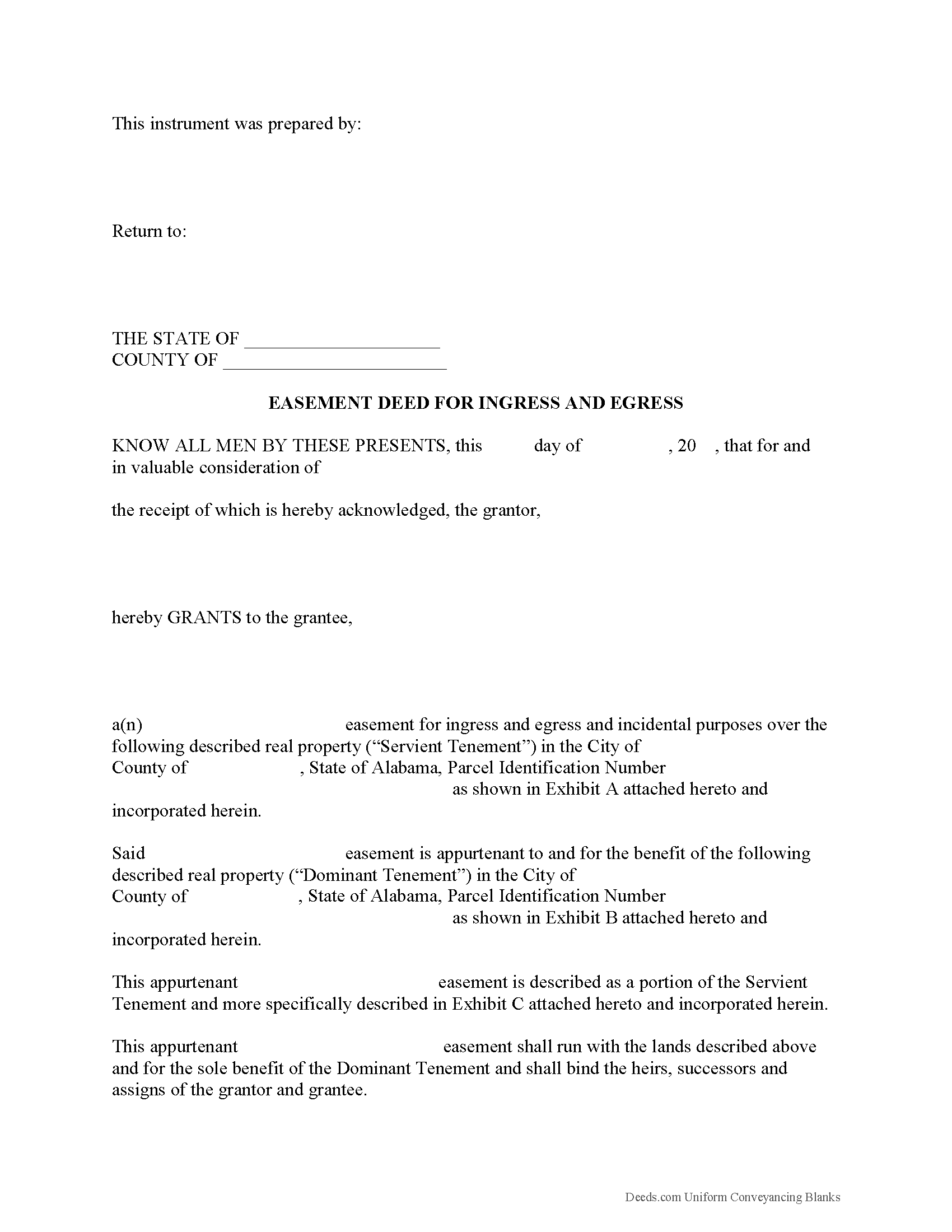Alabama Easement Deed
County Specific Legal Forms Validated as recently as January 2, 2026 by our Forms Development Team

About the Alabama Easement Deed

How to Use This Form
- Select your county from the list on the left
- Download the county-specific form
- Fill in the required information
- Have the document notarized if required
- Record with your county recorder's office
What Others Like You Are Saying
“I just started using Deeds.com but so far it has been a very easy and pleasant experience. I work in…”
— Susan S.“Easy process as I had an example of my other property deeds to work from plus my most current Real E…”
— Carol O.“The forms look great, but I received an Error message when downloading.”
— Lew B.“This was our first time using Deeds.Com. We were tremendously impressed. The website works well, but…”
— Philip S.“So far excellent service - I made a boo boo on the deed - no problem they made the change before the…”
— Rick R.
Easements in Alabama
An easement is a non-possessory right in the holder of an easement to use land. In other words, an easement is a "lesser" interest in the real estate that allows the party benefiting from the easement use the property, such as using it for access, installation of utility lines, etc. [1]
There are three major types of easements; appurtenant easements, easements in gross, and prescriptive easements. The transferability of an easement depends on what type it is. Two parties must be present to create an easement: the grantor, or the servient tenant, is the person who owns the property, and the grantee, or dominant tenant, is the person who is allowed access to the property. Easements can either be exclusive, meaning the servient tenant is excluded from the benefits of the easement, or non-exclusive, where the servient tenant can access these benefits.
Easements can also create restrictions on property use, like prohibiting where someone might build a fence or add a structure to their property. In Alabama, easements do not have to be acquired by express conveyance; they can also be implied or acquired through necessity, as opposed to a formal recorded instrument [3]. Therefore, it is essential to research the property's history for any unwritten easements prior to purchasing land [4].
Easements have some benefits, but there are also negative effects on the property value when they are created. The general use of an easement is to award another person the right to use an owner's land, which be an undesirable arrangement for future owners. Sometimes, easements are used to give utility companies the right to erect power lines or bury gas pipelines across a tract of land, which could possibly affect resale values of a property if people are uncomfortable living so close to power lines, or if the power lines are viewed as unsightly [2].
Record easements in the same manner as other land records in the county where the property is located. A lawful easement includes the grantor's full name and marital status, as well as the grantee's full name, marital status, and mailing address. The purpose of the easement must also be explained in the document. Contact the recording department of the appropriate probate office for information about fees and accepted forms of payment.
After an easement is created, it will be included in the legal description of any following deeds, and it will remain in place when the land is transferred. The only way to remove an easement from a property is for both parties to agree to a release and terminate the easement.
This article is provided for informational purposes only and is not a substitute for the advice of an attorney. Contact a lawyer with any questions about easement deeds or other issues related to the transfer of real property.
[1] https://www.law.cornell.edu/wex/easement
[2] https://robertking.net/2009/10/29/alabama-land-easements-land-accessibility/
[3] Miller v. Harris, 945 So. 2d 1072 (Ala. Civ. App. 2006)
[4] https://www.law.cornell.edu/cfr/text/43/2650.4-7
Important: County-Specific Forms
Our easement deed forms are specifically formatted for each county in Alabama.
After selecting your county, you'll receive forms that meet all local recording requirements, ensuring your documents will be accepted without delays or rejection fees.
How to Use This Form
- Select your county from the list above
- Download the county-specific form
- Fill in the required information
- Have the document notarized if required
- Record with your county recorder's office
What Others Like You Are Saying
“I just started using Deeds.com but so far it has been a very easy and pleasant experience. I work in…”
— Susan S.“Easy process as I had an example of my other property deeds to work from plus my most current Real E…”
— Carol O.“The forms look great, but I received an Error message when downloading.”
— Lew B.“This was our first time using Deeds.Com. We were tremendously impressed. The website works well, but…”
— Philip S.“So far excellent service - I made a boo boo on the deed - no problem they made the change before the…”
— Rick R.Common Uses for Easement Deed
- Transfer property between family members
- Add or remove names from property titles
- Transfer property into or out of trusts
- Correct errors in previously recorded deeds
- Gift property to others